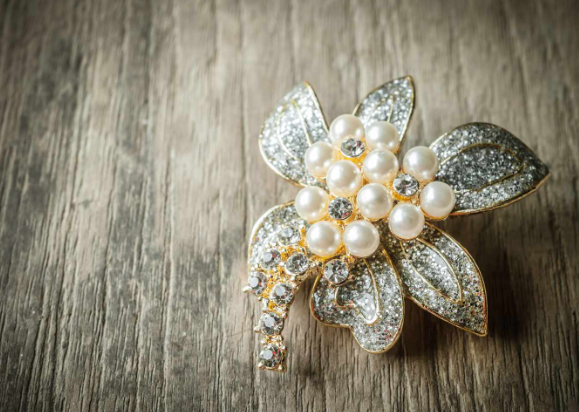Antique Brooches

Brooches are a classic accessory that have become more than just a pin. They are works of art that feature engraving, carving and enamelling.
Closely examining the clasp and hinge of a brooch can help you date it to a certain era. Look for a flat back that resembles a buckle, a tube-shaped hinge for the pin stem and thicker pin stems.
Art Nouveau
Art Nouveau jewellery often shows a lack of straight lines and symmetry. A recurring motif is stylised imagery of flora and fauna. Insects such as dragonflies and butterflies are commonly featured, as are serpents and birds. Landscapes, the female face and body, mermaids and chimeras are also used.
Enamel and other iridescent materials were frequently used to achieve an organic, fluid look. Opal, horn and shell are particularly popular, as is translucent enamel known as plique-a-jour.
Jewelers were inspired by the natural world, and especially by flowers. Their aim was to show the full blossom and seed of each flower, or to depict the petals quivering in the wind. They were also influenced by Japonisme, an artistic movement that celebrated Japanese culture.
Victorian
The Victorian era (from 1837-1901), saw a range of brooches that were popular with women. Cameos, flowers, hearts and animals were all featured. Mourning brooches were also a popular style of jewellery in the 1800s, particularly during Queen Victoria’s two decade long mourning period. Mourning brooches were generally somber and incorporated sentimental designs of flowers, hearts and even encapsulated locks of hair from deceased loved ones. They were often made from black jewellery materials like Whitby jet, vulcanite and black enamel.
The Grand Tour brooch was a style that became very popular during the late 19th century. These were worn by tourists on their European holidays to commemorate the cities and sites they had visited. They were typically designed with intricate mosaic inlays, where semi precious stones were meticulously shaped and fitted together to create motifs or scenes.
Edwardian
This antique Edwardian brooch pin was crafted in 1910. It is emblazoned with the adoring word, REGARD. The brooch features an asymmetrical design, an Art Nouveau-influenced floral pattern and intricate millegraining. It is marked with an anchor for Birmingham, a lion passant and the letter code, ‘l’, for sterling silver, as well as the maker’s mark.
As the Victorian era closed, a new lightheartedness took hold in the world of jewelry. Garlands, ribbons, laurel wreaths and bow knots regained popularity with a more refined lightness that was due to the new fabrication techniques of platinum and the development of millegraining. Necklaces continued to be worn in a variety of styles including ethereal openwork designs, lace-like gossamer creations and long chains with pearls or gemstones.
Art Deco
After World War I, a sense of prosperity and new technologies drove the world to embrace art deco. Sleek ocean liners, streamlined trains, and towering skyscrapers were popular motifs of this aesthetic, which celebrated man-made machines.
Jewelry, architecture, and interior design embraced geometric shapes and symmetry as opposed to the organic and fluid forms of art nouveau. Jewelers sought to create pieces that embodied opulence and the free-spending spirit of the “roaring 20’s” through bright enhancements such as rubies, sapphires and enamel.
The Art Deco movement also introduced a distinctly feminine approach to style, with hemlines rising and ornamentation decreasing as women gained the right to vote and dress according to their own desires. Pattern books and pochoir (a painstaking printmaking technique) were the primary source materials used in this era.
Modern
With their ability to capture the style and personality of their wearer, antique brooches make a powerful fashion statement. From the meaningful mourning brooches that marked Queen Victoria’s 63-year reign to stunning 20th century pieces adorned with precious gems, these jewelry icons have a unique history.
A modern take on a classic look involves combining two or more brooches into a cluster. Selva suggests using a mix of Victorian and Art Nouveau floral pins, Georgian Halley’s Comet motifs in foil-backed gemstones or dainty floral cameos to create a layered necklace.
Another creative way to adorn an outfit is by using a vintage brooch as a hair ornament. Simply fasten a pin to the back of the jewel and then slide it through your bobby pins to secure. This is a trend adopted by many celebrities including Uma Thurman.



